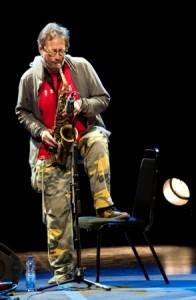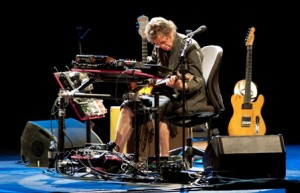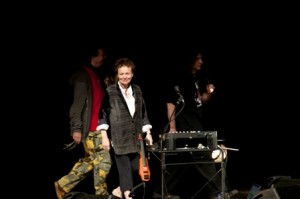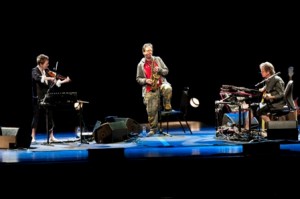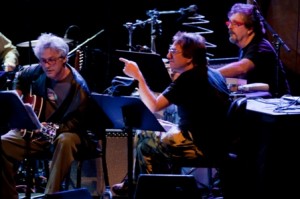Review by Seth Rogovoy
Photos by Denis Alix, Courtesy FIJM
(Montreal, Quebec, July 2, 2010) – There was a moment early into Friday night’s concert at the Montreal International Jazz Festival by Lou Reed, John Zorn, and Laurie Anderson, that felt perhaps like the legendary world premiere of Stravinsky’s Rite of Spring. Apparently a small but vocal minority of attendees had come expecting a Lou Reed concert, thinking for some bizarre reason that Reed was going to perform songs by the Velvet Underground and his solo hits accompanied by avant-saxophonist Zorn and his wife, performance artist and electronic violinist Laurie Anderson.
After the first couple of numbers – which, properly and as billed, were original compositions and improvisations among the three musical visionaries, drawing on their well-known instrumental techniques, which to some ears may have sounded harsh — some clueless fans shouted out requests for songs: “I’m Beginning to See the Light”! “What’s wrong with the Velvet Underground?” “Sing, Lou!” And just plain, “LOU!” which sounds an awful lot like “BOO!”, of which there may have been some (the same thing happens at Bruce Springsteen concerts – “BRUUUUCE!” sounds a lot like “BOOO!”).
After the second song and these responses, with a small but noticeable minority of concertgoers fleeing for the exits, John Zorn took control of the evening and, noting the request for Lou Reed songs, said quite plainly, “If you don’t like this music, you can get the fuck out of here.” And so ended the idiotic requests for Reed hits, as did the feeling that fights or chaos might break out (a la Stravinsky), and the trio played on before a mostly adoring and worshipful audience.
The odd thing is that, while the trio played innovative new music, improvised within constructions, a savvy listener would have recognized the music’s strong roots in the Velvet Underground and Reed’s solo work. Just as abstract painters could take a corner of a jacket collar from some Old Master portrait and make that the sole content of a new painting, what the Reed-Zorn-Anderson trio essentially did was to take an intro, a bridge, or an outro from a V.U.-type song and use that as the raw material for a kind of cubist improvisation – slowing down eight bars from a rock song and stretching them out over five minutes, allowing the musicians to explore the great diversity of texture to be found in the buzz of Reed’s guitar, the peals of Zorn’s sax (playing pretty much the vocal role), and Anderson’s violin playing the approximate role of John Cale’s cello.
Both Reed and Anderson, of course, made extensive use of electronic effects, and Reed in particular had an arsenal of pedals and boxes that allowed him fine tuning of every ounce of buzz and distortion and shift of pitch from his guitar.
It was metal-machine music, for sure, but with a human heart and soul, much of that provided by Zorn’s horn. Perhaps the biggest surprise of the concert was the manner in which Zorn’s patented approach to his instrument, including his musical vocabulary relying on Yiddish modes, blended seamlessly with Reed’s most extreme guitar work. You’d be hard-pressed to find two more highly stylized improvisers, yet they have found a way to make their styles coalesce and speak to each other, in an impressive dialogue full of mutual respect and empathy.
Reed appeared a bit frail – he took the stage haltingly and tentatively in his knee-length short pants as he made his way to his bank of electronics and played guitar seated in a chair the entire night. Zorn took center stage, with one leg perched up on a chair as is his usual style, dressed, as always in camo pants and an orange T-shirt, with tzitzis – Jewish ritual fringes – poking out from underneath his shirt. Anderson was dressed in her usual glam boho-chic, and for the most part of the evening played second fiddle to Zorn and Reed (pun intended), who alternated the lead on each song (Anderson took the lead on the encore).
The music was loud – sometimes on the edge of the pain threshold, but it was also dynamic, making great use of texture and volume and a variety of sounds. A lot of the pieces were shot through with a minimalism derived from V.U. inspiration LaMonte Young as well as Steve Reich. Zorn played repeating ostinatos one minute and then turned on a dime and sounded like the raptors from Jurassic Park – and was equally as scary. Some of the more ambient pieces, featuring waves of harmonic changes, recalled the late-1960s work of Gyrogy Ligeti as well as Brian Eno.
It’s impossible to know what the personal inspiration behind the music was, and it very much could have been sound for the sake of pure aesthetics, and as pure aesthetics it had great beauty and resonance. But it also had tremendous emotional impact, and at times I heard the sound of Lou Reed’s teenage electroshock treatments, or, knowing that Zorn and Anderson recently visited the death camp at Dachau, I heard the sounds of Jewish souls praying and wailing as the Nazi death machine incinerated millions – Zorn’s cantorial playing was the sound of their souls being greeted by angels and flying to heaven, while Reed’s savagery and distortion was the slaying machine.
In another way, this really was merely a jazz trio that just happened to be Reed, Zorn, and Anderson, improvising on head arrangements. In that way, the selection of their program fit perfectly within the framework of a jazz festival – much more so, say, than had Reed sung “Walk on the Wild Side” or had Anderson performed “O Superman,” which also was the subject of shouted-out requests.
That an appearance by Reed, Zorn, and Anderson should be controversial – the Montreal papers and jazz press and weblogs are already full of nasty commentary – should come as no surprise. It is to be expected, and welcome. It’s too bad that so many of the negative reactions to the music are so stupid and predictable in the manner in which they reflect not listeners’ response to what was happening, but rather, their response to what they would have preferred to happen.
Considering this was music with roots as far back as the 1960s, it was probably the most powerful music I heard in my five days in Montreal, music that packed a punch of immediacy and emotional risk, music that at this point in his career, Reed so obviously needs to be making, now more than ever. That Zorn has joined his and Anderson’s orbit – or that they have joined Zorn’s, depending on one’s vantage point – is one of our great turns of fortune, and the mutual respect and graciousness among the three was readily apparent – much more grace, say, than that of those who booed early on and stormed out in ignorance of the musical invention that they were witnessing.
For this listener, it was the perfect ending to a wonderful four days and nights in Montreal. While the night was still young, there could be no more music after this – not for days, really. I made a beeline back to my hotel – I literally didn’t want to hear anything else. I wanted the sheets of apocalyptic sounds to stay with me, untarnished by anything else I might hear. And I cancelled the rest of my musical plans for the weekend back home. (No Dweezil Zappa for me, thank you.)
On Thursday night, Zorn hosted two separate programs billed as Masada Marathons, five hours worth of music by Zorn and his downtown New York collaborators, with a heavy emphasis on his Masada project – loosely defined as a body of work that Zorn has been composing over the past 20 years or so, new works based in large part on Eastern European Yiddish modes. These are works written for a variety of ensembles – string trios, quartets, sextets, vocals, soloists, Afro-Cuban groups, etc., work that while based in the Yiddish modes at the heart of cantorial and klezmer music, speaks directly to listeners with no familiarity with those traditions (and speaks quite deeply to those with an immersion in those modes).
The marathons functioned as a great tribute to Zorn the composer, as well as to the immense talents of those who have joined him as collaborators, co-creators, and vehicles for his creations – many or most of whom have also wound up recording for his record label, Tzadik, and most of whom are leaders on their own on the downtown avant-garde and jazz scenes (Dave Douglas, Cyro Baptista, Uri Caine, to name just three), and some of whom are even called upon to lend their technical skills to pop musicians (Marc Ribot, who has played with Elvis Costello, and drummer Kenny Wolleson, who was Norah Jones’s original drummer).
Zorn served as master of ceremonies for both marathons, introducing the performers by name but pretty much leaving them to their own devices. He only joined in at the end of each segment. The evening kicked off with a performance by the Masada Sextet, which based most of its numbers in an Afro-Cuban groove laid down by drummer Joey Baron and percussionist Cyro Baptista. Zorn stayed on stage and conducted the group in melodies that trod through Henry Mancini in James Bond territory. Zorn used his patented hand signals to shape the music as well as to signal the soloists, who included Ribot on some very surf-guitar like improvisations, as well as cellist Erik Friedlander and violinist Mark Feldman played the role of horns on their strings, “blowing” bebop lines.
Next up was a Masada Piano Trio, featuring keyboardist Jamie Saft backed by bassist Greg Cohen and drummer Wolleson. The music was beautiful and straightforward, almost like Oscar Peterson plays Yiddish. After a few numbers, Ben Goldberg joined the trio on clarinet, opening with an authentic passage of klezmer before steering the proceedings into free jazz territory.
Erik Friedlander took the stage for a solo cello recital. A true virtuoso on his instrument, Friedlander seemingly can do anything on his instrument, whether it’s picking it like a classical guitar, bending notes like the blues, or slapping the strings on a Yiddish folk song.
The first marathon concluded with a sextet, with pianist Uri Caine and percussionist Cyro Baptista joining the core of the original Masada Quartet, featuring trumpeter dave Douglas, bassist Greg Cohen and drummer Joey Baron. Zorn and Douglas have figured out a great thing together, and even though their styles are on their own are oceans apart, they harmonize wonderfully and intuitively, even when Zorn uses his instrument to convey bleats, peals of noise, honks, percussive breath strokes, in addition to conventional played notes. It was a great climax to the opening set of what would prove to me an exhilarating if somewhat exhausting immersion into the world of John Zorn’s Masada.
With just a little over an hour break, the second half the evening marathon kicked off with a piano violin duet featuring Mark Feldman and Sylvie Couvoisier. This was an historically correct setup, as late 19th and early 20th century Yiddish musicians with aspirations to transcend their folk roots and to be considered serious musicians (at this point in history, some were actually conservatory-trained in Russia) favored this recital format. For their first number, the duo recapitulated how a tune played this way may have sounded, but by the second song, they brought the proceedings into the twenty-first century, with Couvoisier reaching into the piano and plucking notes and/or directly pushing the hammers down onto the strings, as Feldman also approached his violin in alternative techniques of plucking and pulling his strings. Still, at heart, it was the same music, just broken down into its more physical, elemental components, and perhaps speaking a more contemporary language more appropriate to a time of violence and destruction (although the early 20th century had plenty of its own in those departments).
Next up was the Dreamers ensemble, featuring keyboardist Saft, drummer Baron, percussionist Baptista, guitarist Ribot, bassist Trevor Dunn and Kenny Wollesen on vibraphone. The group kicked off with a number that sounded like a klezmer-rock tune, with Ribot doing his best Dick Dale tribute while Baron and Baptista kicked it into high gear.
Uri Caine is a musician and composer with vision and originality equal to or surpassing anyone on the bill at the jazz festival, and he was accorded a solo set at piano that showcased his stylistic fusions that drew on classical, early jazz, and Jewish music, before Feldman, Friedlander, and Cohen came out as the Masada String Trio, conducted by a seated Zorn. Probably the prettiest format of the evening, it was an embarrassment of riches with these three players and Zorn’s compositions. It wasn’t klezmer in the sense that Feldman didn’t ornament his playing with the trademark cries and aches, but the melodies were evocative of that music and the musicians were sympathetic to the cadences of the Yiddish.
The second half – and thus, the marathon as a whole, concluded with Electric Masada, an ensemble featuring Baron, Wollesen, Dunn, Baptista, Saft, Ribot, Zorn, and Ikue Mori on electronics. With two drummers and Zorn directing the band through tag-team improvisations, the overall effect was like the Grateful Dead or Santana on Hebrew speed. One number was so metallic it out-metalled Metallica, with a lumbering, ominous riff and thunderous drumming and Zorn’s screeching horns. By the end of the tune, you could smell smoke wafting from the stage, or so it seemed, so hot did the music burn.
This was followed by a dreamy tune scattered with nature sounds from Baptista’s arsenal of hand percussion – shakers, chimes, bells, toys, whistles.
The Masada Marathon was a great tribute to John Zorn the composer, to John Zorn the visionary, to all his collaborators, to the vital, creative downtown scene that nurtures this sort of risk-taking music, and to the Montreal International Jazz Festival itself, for devoting so much prime time to one of the most controversial jazz “outsiders” who is actually as “in” as can be.
Seth Rogovoy is an award-winning music critic and the author of The Essential Klezmer: A Music Lover’s Guide to Jewish Roots and Soul Music, which includes a chapter on John Zorn.

